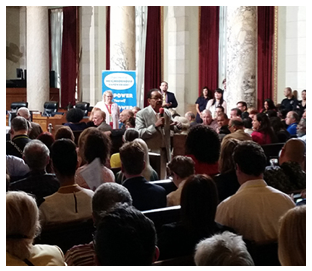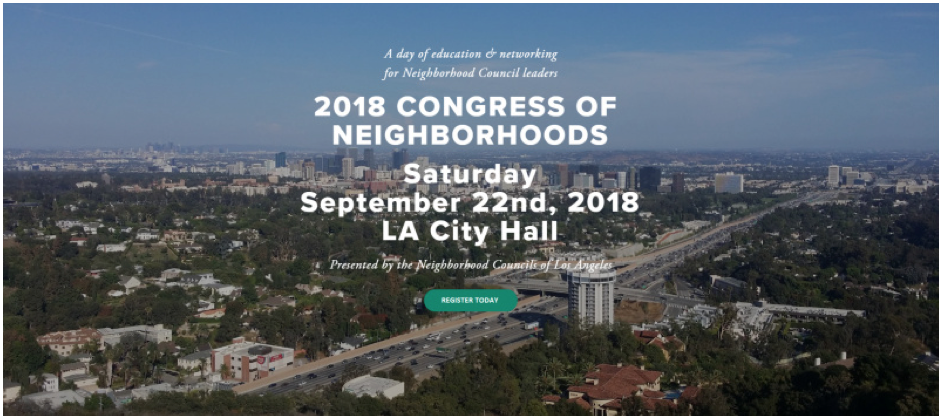CommentsEIGHT MOST READ - GELFAND’S WORLD--The 2018 neighborhood council congress has come and gone, an event in which we were treated to views that were outrageous, insightful, carefully thought out, and sometimes all of the above.
There was an interesting debate about giving real power to neighborhood councils. I will hold off on discussing that one until a later column, as it requires a longer treatment. That leaves two other sessions I participated in. The first dealt with the proposals from City Councilman David Ryu to add reforms to the neighborhood council system. The last session dealt with the overall structure of city government -- do its deficiencies merit a wholesale restructuring of the way we elect the people who rule over us?
These latter two sessions also merit serious discussion. Luckily, for them, we can get by on fewer words. Let's start with the Ryu proposals.
The Ryu motion was not at all trivial -- actually it's complex, with at least a dozen separate subtopics -- but numerous groups at every level have already published their own feedback. Let's consider a few of the comments that were heard on Saturday.
Curiously (to me, at least) there were strongly held views on whether or not the city should rename the commission (currently the Board of Neighborhood Commissioners) and the department (currently the Department of Neighborhood Empowerment or DONE). Some participants felt that the attempt by DONE to call itself EmpowerLA had resulted in public confusion, and we would all be better off going back to the original version. Others pointed out with equal vigor that DONE is a confusing term (what, actually, does it mean?) and would be better replaced with something like Department of Neighborhood Councils. Although this would result in the ungainly substitute DONC, it would be both descriptive and accurate.
Another interesting debate arose over whether the city should invite the Board of Neighborhood Commissioners (whatever they end up being called) to carry out a study of whether each neighborhood council apportions its board seats in a fair and equitable way. Should the governing board of Alluvial City assign half its board seats to local business owners, one-quarter of its seats to homeowners, and the remaining seats to auto repair shops? It's a fair question, but the underlying dispute (actually two disputes) are clear: First, who should be the judge? Second, is it a useful thing to relitigate these issues at this point, considering that most neighborhood councils have been around for at least a decade?
The discussion did elicit from Ryu's staffer that there was no intent to force changes on neighborhood councils. This by itself would seem to imply that the proposal will die quietly in committee, because neither the BONC nor the individual councils are asking for it.
One of the Ryu proposals would allow each neighborhood council to roll over a sum of up to ten thousand dollars of unspent budget. In a room crammed full of people of many backgrounds, there was essentially unanimous support for this proposal. I suspect that Ryu's staffer will be able to argue that they have a winner in the rollover suggestion.
As to the question of whether the city should mandate training of neighborhood council participants who participate in land use advisements, there was some controversy but it appeared that a majority supported the idea. Yours truly disagreed based on my insistence that neighborhood councils need to be independent of centralized rule as much as possible. Those in attendance were not of the same mind.
* * *
Can and should we redesign city government?
 The pros and cons are simply put: The current organizational structure of the City Council puts enormous power in the hands of 15 people, each of whom has a lot of authority over the lives of more than a quarter-million people. The opposing argument is that the current system works, however imperfectly, and the elected members of the City Council aren't going to support diluting their own power. This left a small but intense group of participants to discuss what might be. Should change become possible, what direction should it take?
The pros and cons are simply put: The current organizational structure of the City Council puts enormous power in the hands of 15 people, each of whom has a lot of authority over the lives of more than a quarter-million people. The opposing argument is that the current system works, however imperfectly, and the elected members of the City Council aren't going to support diluting their own power. This left a small but intense group of participants to discuss what might be. Should change become possible, what direction should it take?
I'm going to modify my usual approach by incorporating a fairly long YouTube video that was communicated by somebody who saw the meeting announcement but was unable to attend the meeting itself. It is pertinent because it raises arguments that we don't ordinarily see in such discussions.
Mike Feinstein served on the Santa Monica City Council, including a two year stint as mayor. He represents the Green Party, unusual for a big city politician. The link to Feinstein's discussion can be found here.
Feinstein raises the question of low voter turnout and links it to the current winner take all system we have for electing the City Council. The idea that the current system by itself damages voter incentives is both novel and convincing. The opposition view might be that we don't want to encourage an incentive to dilute the effects of the current election process. Would a City Council divided among Greens, Libertarians, Peace and Freedom members and independents be a better way of running the city, or would it be a recipe for stasis?
One solution to this question is to create council districts which are represented by 3 members instead of just one. This would largely solve the current problem in which one City Council member has near-monopoly power over land use decisions within his entire district. It would certainly be an interesting government if any one council district could be represented by a Republican, a Democrat, and a Green. Those unilateral decisions (can we say Sea Breeze project?) would be harder to force through.
The question of the current level of City Council salaries also came up. The participants had no problem with the idea of cutting the current salaries substantially. This would solve the question as to how to pay for all those additional council members. One participant raised an interesting question: Would cutting salaries result in a more corrupt City Council? Although there were some knowing nods, I'm not convinced that the answer is clear. Certainly there are lots of small cities with unpaid or low paid City Councils, and they are a mix of clean and not so clean.
* * *
This 2018 version of the annual neighborhood council convention was an additional step forward in an evolving system. The idea that neighborhood councils should not be "silos" but should work together goes way back in our history. It began with the original Alliance of Neighborhood Councils and continues with the Valley Alliance of Neighborhood Councils (VANC) and the citywide Los Angeles Neighborhood Council Coalition (LANCC). Several regional alliances (westside, harbor, eastside) have come into being. In addition, several topically related alliances (sustainability, emergency preparedness) are following in the footsteps of the original LADWP MOU group.
The intent among organizers of such groups ought to be that we get tens of thousands of Los Angeles residents involved. We are part of the way there at the moment.
(Bob Gelfand writes on science, culture, and politics for CityWatch. He can be reached at [email protected])
-cw
















